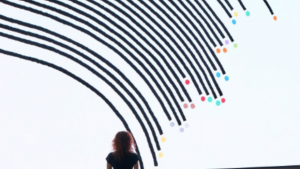“The Sun Also Shines in the City” is the name of Design Academy Eindhoven graduate Frederik Deschuytter’s graduation project. It responds to the stigma against integrating solar power technology in urban settings, as he explains, “Instead of facing this issue, developers rather banish innovative energy sources to isolated areas”.
We asked the designer about the project’s moment of origin. He described a fateful train trip that made him think critically about the geographical placement of renewable energy plants.
“The most critical moment arose during a train ride to the south of France. When gazing out of the train’s window, I suddenly saw a huge solar power plant surrounded by trees. Upon opening Google Maps, I was astonished to discover we rode along a vast forest, far removed from the inhabited world. I couldn’t comprehend why anyone would build such an installation at a location where absolutely no energy is being used,” Deschuytter said.
Describing the research that soon followed, he said, “I investigated recent developments concerning sustainable energy production, only to find that renewable energy sources like solar power don’t have a prominent spot in the urban landscape. They seem to be an eyesore to architects and are therefore banished to remote locations.”
“The Sun Also Shines in the City” takes form as a model of urban streets, in the middle of which is a massive pillar. Deschuytter's urban landscape has a vast collection of mirrors scattered across the rooftops of its buildings, all configured to catch sunlight and direct it to a central focal point – the massive solar tower.
Instead of trying to camouflage or awkwardly accommodate a solar power system into an existing city landscape, Deschuytter’s project turns it into a skyline-defining feature. The light-absorbing tower would become a monument, perhaps even a source of civic pride for citizens.
Additionally, such a spectacular tower would confront citizens with a visual reminder of their source of energy, potentially resulting in more efficient use of power at large.
Recognising that such a dominant civic feature could inspire a backlash, Deschuytter explained, “History has taught us that radical urban interventions are usually met with opposition. A good example of this is the Eiffel Tower, whose striking appearance initially was offensive to many. Based on this knowledge, I tried to give shape to a structure which is both radical and moderate in appearance – a future landmark that draws attention without damaging the urban landscape.”
Speaking about the kind of projects that he regards as important to him and those he wants to embark on moving forward, the designer said, “I would define myself as a conceptual and speculative thinker. I generate ideas which can open up discussion about possible future scenarios. Though this specific project is technically feasible, the underlying mode of thought is nonexistent and therefore hypothetical.”
“As a designer, I feel responsible for the world surrounding us. With global warming being one of the greatest challenges of our time, environmental design is without doubt one of my top priorities. With ‘The Sun Also Shines in the City’ I present a new way of thinking which can be applied not only to solar but to any renewable energy source. Therefore, this project is only the start of a greater whole.”











